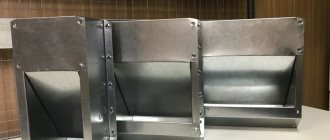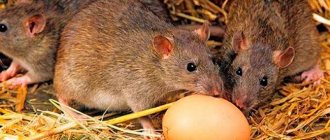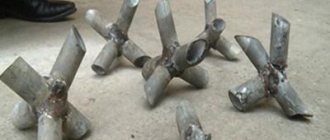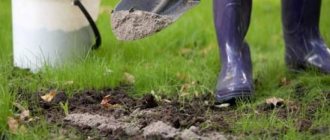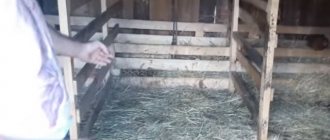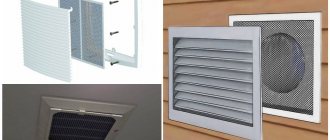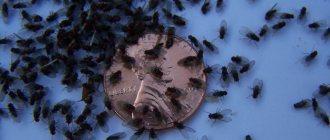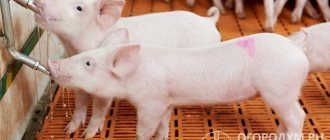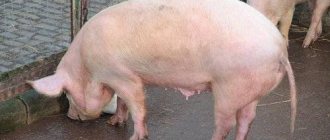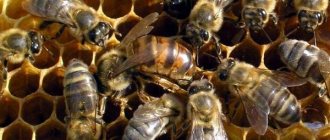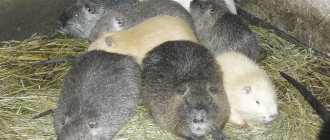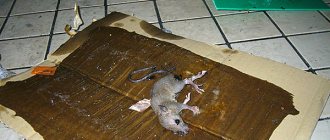In autumn, winter, and most of spring, animals are constantly indoors. Their waste products emit a dangerous substance - ammonia. In addition, the concentration of carbon dioxide in the barn is significantly increased. Agree that constant ventilation is not a solution, especially in twenty-degree frost. But ventilation in an animal shed is no less important than heating.
Drafts do not have the best effect on the health and offspring of animals. At the same time, you can’t do without air circulation. Therefore, in addition to insulating the building, it is also necessary to take care of the ventilation system. The latter must ensure normal microclimatic conditions, including air temperature, cleanliness and freshness.
In this article, we examined the basic rules of ventilation in animal sheds and provided standard values for temperature and humidity indicators for rooms in which animals are kept. We also described the procedure for arranging an effective air exchange system, providing instructions with visual photos and useful videos.
The importance of the microclimate in the barn
Often, owners do not bother creating optimal conditions in the barn. In the best case, holes are made in the wall in the room.
But the importance of oxygen indoors cannot be underestimated, because animals must live in an insulated and well-ventilated barn. During the construction of which it is advisable to use sawdust, hay or straw. Materials of natural origin perfectly absorb and retain moisture.
Maintaining proper air exchange reduces the incidence of disease in animals, and improves weight gain and the number of offspring.
A grill should be installed on the ventilation openings. A device made of metal or plastic will help protect against rodents. Using the valve installed inside, you can adjust the supply of fresh air in winter
In the warm season, you can prevent the appearance of a musty smell in the room and the spread of mold through ventilation.
In winter, it is not advisable to open doors and windows. After all, the temperature should be maintained within +18-+22 degrees Celsius. Deviation of indicators from the norm increases the risk of colds.
general information
Problems faced by people who keep animals in a barn without ventilation:
- Drafts. They are harmful not only to people, but also to animals. The presence of drafts during ventilation increases the likelihood of animal disease.
- Lack of air flow makes it musty and stagnant.
- High humidity is an excellent environment for the development of bacteria, mold and mildew.
Installing ventilation in a barn is not an easy task. When installing a classic supply and exhaust air exchange system, a person faces three problems:
- high humidity levels;
- decrease in average room temperature;
- freezing and blocking of the exhaust pipe.
The presence of such problems is incompatible with keeping animals, so it is necessary to plan a design with a number of characteristic features.
There are two ways to solve problems with hypothermia and humidity. The first method is to use materials that absorb moisture well in the construction and finishing of the barn. Such materials include: quicklime, sawdust, straw, hay, moss and peat. The materials used can be placed in boxes or used as natural bedding, replacing it periodically.
It is recommended to use peat, as it can absorb a volume of moisture that is several times its own size. The sawdust must be dried; wet material will give off moisture rather than absorb it.
The second method is equipment next to the heater inlet. This method is risky and wasteful. The equipment will constantly consume electricity, and its operation creates a fire hazard.
Only oil or infrared heaters are allowed to be installed. Its presence will allow the incoming fresh air to dry. The heater must be located in an isolated place. The main advantage of heating equipment is that it solves two problems at once: removing moisture and heating the air.
There are two standard types of ventilation system that can be used in a barn:
- natural;
- forced.
The natural system is designed in such a way that air exchange is carried out only through the proper placement of pipes. The forced system operates with the help of additional equipment (fans).
Networks with built-in fans are more efficient and convenient to use, as they allow precise regulation of the microclimate in the room. But such ventilation is more expensive and complex.
For a barn with chickens, rabbits and other animals, a natural system is suitable. Its main disadvantages are low productivity in the summer, when the temperature outside is high, and dependence on weather conditions (precipitation, wind).
Typical mistakes during construction
The barn can be a free-standing building or attached to the house. As a rule, premises are built on the principle of “how to save money.” They often erect it independently and quickly.
You can prevent the spread of mold spores by using ventilation holes. The so-called vents should be placed around the entire perimeter of the barn
There are several main problems with such an object:
- Cheap foundation . Blocks and tires with concrete are used as the basis of the room. In the best case, they make a strip foundation. There is practically no waterproofing and insulation of this part of the building. And this causes free transfer of cold and moisture from the soil into the room.
- The floor often remains earthen . If you don't raise it a little higher, the air inside will be cold in winter.
- There is also no external waterproofing or wall insulation . Or they do it in the simplest way and make big mistakes. As a result, significant costs will be required for heating, and the building cools down very quickly.
- Insufficient natural light or its complete absence. One small window is made in the barn. And the importance of sunlight is difficult to overestimate, because ultraviolet radiation repels mold.
The presence in the building of all the listed defects or some of them leads to an increase in the level of humidity, disruption of air exchange, which is manifested by the complete absence or lack of fresh air, severe cold.
How to build a rabbitry
Housing for long-eared pets can be created using a frame-and-plank structure. Such a barn is not large in size, but inside it should be divided into zones or separate cages for furry animals should be installed. It is better to keep rabbits one at a time to control the breeding process. For females with cubs and ungrown young animals, a more spacious corner with insulation and artificial light is allocated.
Video - Construction of a rabbitry
In general, the construction of a wooden rabbitry resembles the process of constructing a poultry house described above. But in this case the room should be larger and higher. It is more convenient to arrange the cages inside in two rows to save space. Therefore, for 10 animals you need a barn with dimensions of 3x5 m and a height of 2-2.5 m. The building needs a stable foundation on a reinforced frame filled with concrete. A timber structure covered with edged boards is installed on it.
Tips for a Rabbit Shed
Shred cages are installed inside the rabbitry: adjacent cells with a front mesh wall. Most often they are installed in several tiers - two or three. Feeders and drinking bowls are hung on the front part.
Rabbit barn
Destructive consequences for the building
The listed violations will directly affect the utility unit:
- High humidity and regular temperature changes, especially if the structure is built from wooden materials, will accelerate the destruction of the barn. The finishing will also suffer, of course, if it was done. Unfavorable climatic conditions lead to damage and shedding of building materials. It will be necessary to carry out restoration work.
- The spread of mold also leads to the destruction of the room. Disputes can spread to other premises, including a residential building.
Insufficient air exchange causes the accumulation of gases from manure. And this is fraught with the creation of an unpleasant odor, which is extremely dangerous for human health.
Mold on the walls and ceiling increases the incidence of illness in animals. In addition, cows’ milk yields are reduced, calves and piglets gain worse weight, and the productivity of other animals decreases
If part of the shed is used as storage space, the property can quickly deteriorate.
This especially applies to wooden products, in particular firewood and furniture, and metal objects that are prone to rust. Fabric will also be damaged, for example, old clothes, which are often stored in sheds.
Preparatory work
Before working on the ventilation system, it is necessary to build a good-quality barn that is convenient for livestock. Many people are used to making rooms anyhow. A simplified approach to a serious matter, the desire to save on everything leads to serious problems:
All this can be avoided if you plan and build a modern barn without haste, taking into account the number of animals.
Ventilation measures may be unnecessary if the room is not insulated. To achieve this goal, dry sawdust, peat, hay, and straw are used as bedding. Quicklime is placed in the corners to absorb moisture. In order to reduce the level of dampness, heaters are installed near the suction openings.
Standards and principles of ventilation design
In a non-residential area where things will be kept, the ventilation system should be a multiple of 1. This means that within 60 minutes the air in the barn should completely change. Ventilation according to this technology must have a performance that exceeds the volume by 15-30 points. If items that become unusable due to high humidity levels are stored inside, the circulation rate should be increased by one and a half or two times. We discussed warehouse ventilation standards in more detail in this material.
In the case of small private farms, when various animals are kept indoors - from bulls to sheep, the air exchange rate should be 4. This indicator can also be used by owners of mini-farms, where there are only two or three cows or ten rabbits.
But for a large number of livestock, creating optimal conditions involves not only focusing on the air exchange rate . temperature and humidity are important . The optimal humidity level is about 80. The coefficient can be determined using a psychrometer.
The level of indicators will differ for different animals - for example, the standard temperature for keeping cattle is 8-10 degrees with a humidity level of 70%. You can read more about barn ventilation in our other article.
Norms of microclimatic conditions, including temperature, relative humidity and gas concentrations for keeping cows in the autumn-winter period
Estimated values of air temperature in premises for keeping sows and boars, young animals, maximum and minimum levels of relative humidity
The data presented are used in large livestock farms with modern ventilation and heating systems. In an ordinary shed on a summer cottage, creating similar conditions will be much more expensive and difficult.
Arrangement of natural air exchange
This option can be called the simplest and cheapest, but also the least effective. After all, natural ventilation largely depends on the location of the building, as well as weather conditions.
You can arrange it as follows:
- Air flow is provided through a gap under the door or window. The ventilation system may also include a supply valve located at the bottom of the wall or a grille in the door.
- As a hood, it is advisable to use a pipe leading outside through the roof or wall under the ceiling. The external opening should be located above the ridge of the roof. To improve traction, a deflector should be installed on top of the hole.
But the natural ventilation scheme is not suitable for all rooms. In some cases, it will only make problems worse.
It is undesirable to choose this method of air exchange in the following cases:
- If the shed area is more than 30 square meters.
- Around the building there are taller buildings or branchy trees growing. Exhaust ventilation will not work well if the area where the utility yard is located is in a lowland.
- There is no foundation or it is not waterproofed or insulated.
- There is a high level of humidity indoors. With natural ventilation, humidity will increase even more during precipitation.
- Moisture condenses on the ceiling and walls of the building, which means that the problem can only be solved with the help of external insulation of the building.
It is also undesirable to use only this type of ventilation if animals will live in the room all year round or objects that are susceptible to mold will be stored.
Forced ventilation scheme
The mechanical system ensures forced air circulation regardless of weather conditions.
In sheds with a small area, you can arrange ventilation yourself: mount a fan on the hood, and leave the inflow natural.
In a room with a large area, for example, from thirty square meters, or if the building is very elongated, you can make several points of inflow and exhaust. It is very important to “get rid” of all corners where air stagnates.
In a barn for animals, making ventilation yourself is not so difficult:
- The inflow is provided through a window or a gap under the door. You can install a supply valve at the bottom of the wall or install a grille in the door.
- To remove air, a pipe is used, which is preferably installed through a wall under the ceiling or roof. A duct fan should be placed in the interior. The element should be covered with a protective cap on top.
The easiest way to independently install an exhaust pipe is to carry out the pipe through the wall under the ceiling. In this case, there will be no need to seal the hole through the roof. A forced exhaust hood should be installed in a small shed opposite the inflow, that is, on the opposite wall.
In fact, the only difference compared to a natural system is the installation of a fan in the exhaust pipe. For a small shed, a device with low power is sufficient; the price of such a unit will be about 5 thousand rubles. Even with continuous operation, electricity costs will be only a couple of hundred rubles per month.
How to properly make natural ventilation in a chicken coop from plastic pipes with your own hands
The easiest option is to make a natural hood in the chicken coop with your own hands. To do this you will need plastic pipes, fasteners, tools for work and insulation. Step-by-step instruction:
- Take two sewer pipes of the same dimensions - diameter 200 mm, length 2 m.
- Mark the places for their installation - at the maximum distance from each other.
- Drill the required holes in the ceiling and roof using a jigsaw (diameter with a margin of 10–15 mm).
- Install the supply pipe at a height of 30 cm from the floor, and the exhaust pipe 20 cm below the ceiling. Secure with hoops.
- Completely seal the holes using foam.
- Install the head on the top of the pipe.
Supply and exhaust ventilation system diagram
Automation of ventilation systems in a barn
It is advisable to improve the ventilation system if there are always animals in the room or valuable property is stored.
There are several options for how to properly ventilate a barn:
- using a humidity sensor;
- using a temperature sensor.
If you configure the exhaust fan to start using a humidity sensor, then the device will turn off when the psychrometer reading is normal. And increase the speed if, at an acceptable level of air humidity, the fan operates at minimum speed.
For smaller sheds, it is not necessary to install a fan with a temperature or humidity sensor. Or at least it should be done when absolutely necessary
You can start or stop the fan, or change its speed using the temperature sensor. Especially if the building will be used to keep animals. In the summer, the fan will turn on or increase speed during the heat.
In winter, on the contrary, when the temperature in the room drops, the fan will stop working altogether or slow down.
There are several ways to maintain the temperature at the proper level:
- Ventilation units are combined with heaters - steam, water and electric.
- The heating and ventilation device is installed in a special chamber or under the guise of a monoblock directly in the room.
- You can also save thermal energy using heat recovery units built into the ventilation system.
- By installing supply and exhaust ventilation with heat recovery and recycling.
After installing ventilation, it is important to test it before use.
Failure to install mechanical fans can increase their noise up to 100-120 dB. The intensity of a properly adjusted system should average 57-80 dB
How to calculate the size of a pigsty?
In order to correctly design a future building, you need to decide on its dimensions. We will consider separately how to calculate the area and height of the barn.
Square
It is believed that one animal should receive about 3-5 square meters. m. So, if you need to build a pigsty for 10 heads, then its area should be at least 30-40 square meters. m. However, for a more accurate calculation of the area of the premises, it is advisable to take into account the age of the animals, as well as the way they are kept - breeding or fattening. Standard standards are given in the table:
| Livestock | Number of animals in the pen | Machine area | |
| with breeding maintenance | when kept for fattening | ||
| Boars | 1 | 8 sq. m | 8 sq. m |
| Sows: | |||
| single and pregnant up to 2 months | 4 | 3 sq. m | 3 sq. m |
| pregnant at 3 months | 2 | 6 sq. m | 3.5 sq. m |
| sucklings with piglets | 1 | 10 sq. m | 7.5 sq. m |
| Piglets: | |||
| young animals up to 5 months | 10-12 | 0.6 sq. m | 0.5 sq. m |
| breeding boars aged 5-8 months | 2-3 | 1.15 sq. m | — |
| fattening piglets aged 5-6 months | 20 | — | 0.7 sq. m |
| fattening piglets aged 6-10 months | 15 | — | 1.0 sq. m |
For example, let’s calculate the optimal dimensions of a pigsty for 100 heads. Let's say there are 5 sows, 90 piglets, 1 breeder boar and 3 breeding pigs in the herd. Piglets are expected to have 2 farrows per year, so they need to be kept in pens of different sizes. Based on these data, the calculation is made in the following order:
- Calculate the area for each category of animals:
- for sows with piglets – 5x10 sq. m = 50 sq. m;
- for a boar – 1x8 sq. m = 8 sq. m;
- for older and younger piglets – 45x1 sq. m + 45x0.5 sq. m = 67.5 sq. m;
- for young pigs - 3x1.15 sq. m = 3.45 sq. m.
- Add all the obtained values – 50+8+67.5+3.45 = 128.95 sq. m.
- Calculate the length and width of the area used for the machines. Let’s say that machines with a depth of 3 m will be located in 2 rows, and passages will be organized along the walls - 2 longitudinal and 1 transverse. To calculate the length of the pigsty, you need to divide the calculated area by twice the depth of the pen and add the width of the passages: 130/(3x2)+1.5 = 23 m. As for the width, the calculations are as follows: 3x2+2+2 = 10 m.
Thus, the optimal area of a pigsty for 100 heads is 130 square meters. m, length and width – 25 m and 10 m, respectively.
Here are examples of pigsty drawings:
Height
When determining the height of the room, you need to take into account the following nuances:
- if the construction is planned to be carried out without a ceiling with open beams, the maximum height of the walls is 2.6 m;
- if thermal insulation is laid under the roof for insulation purposes, the optimal height of the room from the walls to the beams is 1.8 m;
- if the ceilings are flat, they must be installed at a height of at least 2.2 m.
In any case, the height of the external walls of the pigsty cannot be less than 1.6-1.8 m, otherwise the air in the room will be poorly ventilated. The highest point of the ceiling should be at the level of 2.2-2.6 m. It is better to make the roof itself 1- or 2-slope.
How to correctly calculate the dimensions of a pigsty in order to make it from boards, learn from the video below:
Recommendations for choosing the type of ventilation
Each type of air exchange has its own advantages and disadvantages; several factors should be taken into account before installation:
- The amount of fresh air entering the room - in the warm season, the flow increases.
- The influence of natural conditions on the ventilation system, including average annual temperature and wind direction.
- The location of the barn is in a lowland or on a hill.
- Dimensions of utility room.
- Number of livestock.
And only after finding out the climatic conditions and how the air circulates inside the building can you begin to install one of the types of ventilation systems.
In addition to animals, do you also have poultry on your farm? In this case, we recommend that you read our other article about ventilation in a chicken coop.
Tests
After the socket and switch are installed, and the light bulbs are screwed into the lampshades, you need to carry out the first test run. If after switching on the lights are on, the socket is functioning, everything is in order, the work has been successfully completed.
If the lights do not light up or blink or the wiring sparks, you need to check the circuit for breaks and tighten the screws of the machine more tightly. Problems can be caused by a phase-zero mismatch, a violation of the integrity of the insulation in twists, or a connection of copper with aluminum.
We must not forget about safety precautions: do not work with a connected network, use insulated tools, avoid getting moisture on wires and devices.
System diagrams for a large pig farm
Providing air exchange for a large pig farm is a more difficult task. Almost always such buildings are made in the shape of a rectangle - this is exactly the option we will consider.
The system can be implemented in several ways:
- Roof (or shaft) scheme.
- Longitudinal.
- Tunnel.
- Transverse.
These options are not the only ones, but they are the most common for large pig farms.
Each scheme can be implemented either as a natural system (without fans) or as a forced system (with fans). Usually fans are placed on the exhaust, but for large farms the inflow can also be forced.
It is impossible to say which scheme is better: the differences are essentially only in the location of the inflow and exhaust points.
Below we will consider each option in more detail.
Roof (shaft)
In this case, the inflow points are located along two opposite walls, along their entire length. Exhaust ventilation - mounted in the center of the roof.
It turns out 3 parallel lines: there is an inflow along two walls from below, and an exhaust in the center. Air passes from both sides of the walls and is removed in the center of the room.
There is another option for this scheme: the inflow point is located in one wall, and the hood is discharged through the roof near the opposite wall.
Longitudinal
In this case, the inflow points are located along the entire length of both long walls. Air removal is carried out at one of the ends of the building.
The opposite end remains “deaf”: there is no inflow or exhaust in it.
Tunnel
This scheme is similar to the longitudinal one: air is removed through one of the end walls.
The difference is in the inflow: it is not made along the entire length of the long walls, but only in a small part of them, which is located closer to the second end. It turns out that the air moves from two corners from one end of the pigsty to the wall opposite them - like through a tunnel.
Transverse
The arrangement is organized as follows: the points of air inflow and removal are located along two opposite long walls.
Along the entire length of one wall, air supply devices (vents, valves or fans) are installed. Exhaust fans are installed along the entire length of the opposite wall (or exhaust pipes are removed).
